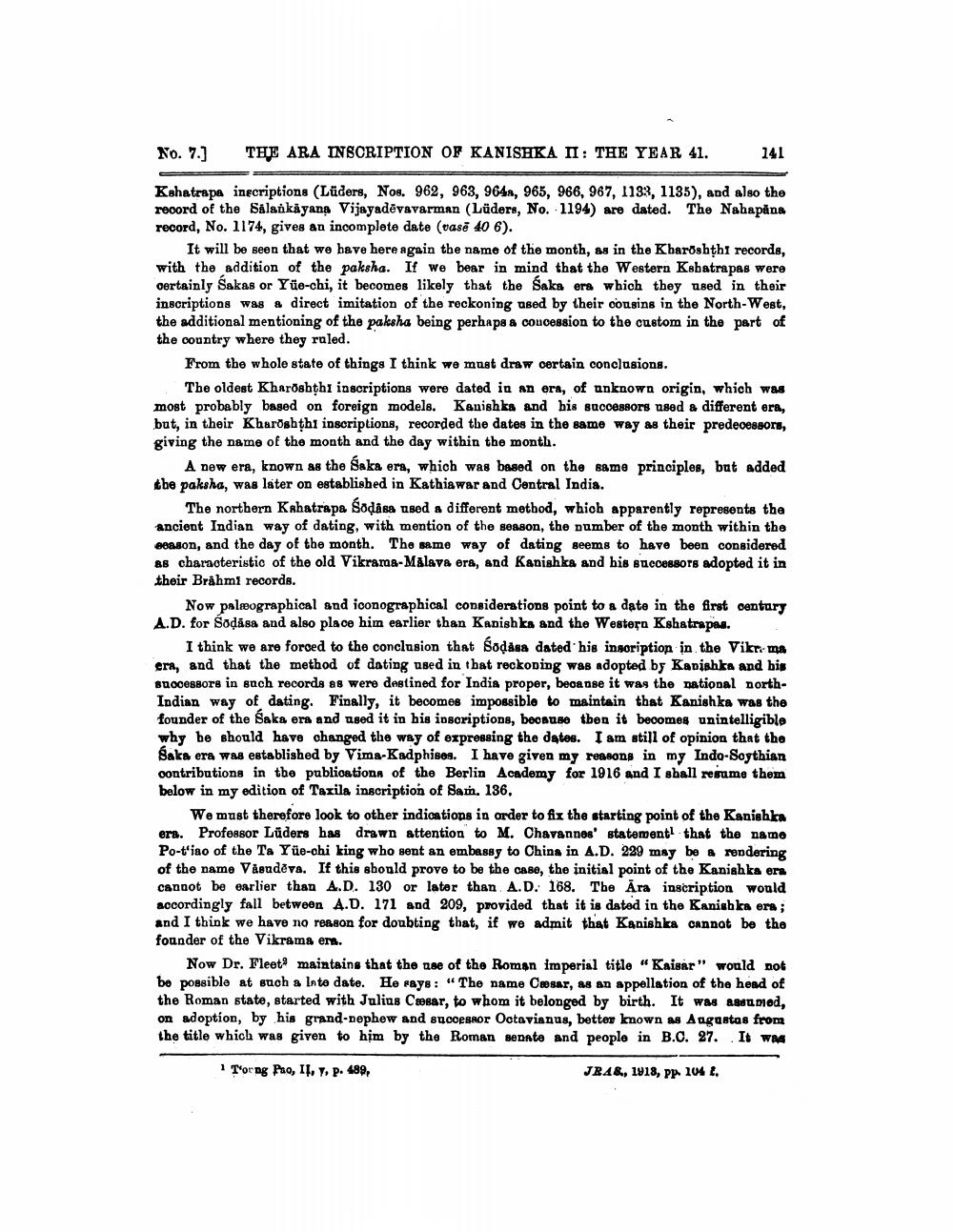________________
No. 7.]
THE ARA INSCRIPTION OF KANISHKA II: THE YEAR 41.
141
Kshatrapa inscriptions (Lüders, Nos. 962, 963, 964a, 965, 966, 967, 1133, 1135), and also the record of the Salankäyana Vijayadēvavarman (Lüders, No. 1194) are dated. The Nahapana record, No. 1174, gives an incomplete date (vasē 40 6).
It will be seen that we have here again the name of the month, as in the Kharðshthi records, with the addition of the paksha. If we bear in mind that the Western Kabatrapas were certainly Sakas or Yüe-chi, it becomes likely that the Saka era which they used in their inscriptions was a direct imitation of the reckoning used by their cousins in the North-West, the additional mentioning of the paksha being perhaps a coucession to the custom in the part of the country where they ruled.
From the whole state of things I think we must draw certain conclusions.
The oldest Kharðshthi inscriptions were dated in an era, of unknown origin, which was most probably based on foreign models. Kanishka and his successors used a different era, but, in their Kharoshthi inscriptions, recorded the dates in the same way as their predecessors, giving the name of the month and the day within the month.
A new era, known as the Saka era, which was based on the same principles, but added the paksha, was later on established in Kathiawar and Central India.
The northern Kshatrapa Sodála used a different method, which apparently represents the ancient Indian way of dating, with mention of the season, the number of the month within the eeason, and the day of the month. The same way of dating seems to have been considered As characteristic of the old Vikrama-Malava era, and Kanishka and his successors adopted it in their Brahmi records.
Now paleographical and iconographical considerations point to a date in the first century A.D. for Sodása and also place him earlier than Kanishka and the Western Kshatrapas.
I think we are forced to the conclusion that sodass dated his insoription in the Vikrama era, and that the method of dating used in that reckoning was adopted by Kapishka and his Successors in such records as were destined for India proper, beoanse it was the national northIndian way of dating. Finally, it becomes impossible to maintain that Kanishka was the founder of the Saka era and used it in his inscriptions, beat.80 then it becomes unintelligible why he should have changed the way of expressing the dates. I am still of opinion that the Saks era was established by Vima-Kadphises. I have given my reasons in my Indo-Soythian oontributions in the publications of the Berlin Academy for 1916 and I shall resume them below in my edition of Tazila inscription of Sam. 136.
We must therefore look to other indications in order to fix the starting point of the Kanishka era. Professor Lüders has drawn attention to M. Chavannes' statement that the name Po-t'iao of the Ta Yüe-chi king who sent an embassy to China in A.D. 229 may be a rendering of the name Våendeva. If this should prove to be the case, the initial point of the Kanishka era cannot be earlier than A.D. 130 or later than A.D. 168. The Āra inscription would accordingly fall betweon A.D. 171 and 209, provided that it is dated in the Kanishka era; and I think we have no reason for doubting that, if we admit that Kanishka cannot be the founder of the Vikrama era.
Now Dr. Fleet maintains that the nee of the Roman Imperial title "Kaisar" would not be possible at such a Into date. He says: “The name Cesar, as an appellation of the head of the Roman state, started with Julius Caesar, to whom it belonged by birth. It was assumed, on adoption, by his grand-nephew and successor Octavianus, better known as Augustas from the title which was given to him by the Roman Benate and people in B.C. 27. It was
1 Tor ng lao, IL, 6 P. 489,
JR48, 1918, PP. 104 2.




